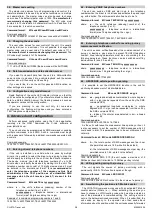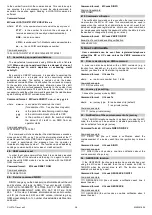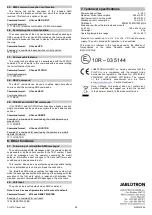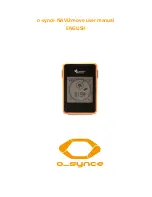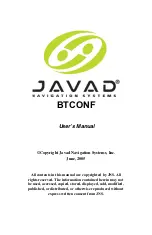
CU-07A Tracer unit
2/4
MKW51604
3.2. Master code setting
The master code serves for unit programming and control. It is
therefore intended to be used by a service technician or a multiple
unit administrator. The master code can also be used to change
user codes. The default master code is 1234.
The manufacturer
recommends changing this password.
The MC code must
contain 4 to 10 characters. All characters from A to Z and from 0 to
9 are accepted, it is not case-sensitive.
Command format: MCcode MC newMCcode newMCcode
Command example:
1234 MC CU654321 CU654321 (the new code will be CU654321)
3.3. Changing the user code
The user code serves for user control of the unit. It is usually
used by a driver or a unit user. It is not possible to change the
master code using a user code. The default user code is 1111.
The manufacturer recommends changing this password.
The
UC code must contain 4 to 10 characters.
Command format: UCcode UC newUCcode newUCcode
Command example:
1111 UC AUTO988 AUTO988 (the new code will be AUTO988)
3.4. Data transmission to a data-collection server
If you want to transmit data from the unit to a
data-collection
server in order to process it into a vehicle logbook, ask the service
provider who will then carry out the setting.
If you would like to use the unit for passive SMS location, no
other settings are required.
3.5. Configuration entry mode timeout
Rapid flashing of the unit's LED indicator informs you that the
unit has not been configured yet. If you therefore intend to transmit
data to a
data-collection
server, the flashing ceases as soon as
the operator carries out the configuration.
If you are planning to use the unit only for non-server
configuration, the flashing will cease once you have entered a
TEL1 telephone number (see 4.1).
4. Advanced unit configuration
Perform advanced configuration using the C-Link application
remotely via the GSM. Download the C-Link software at
www.jablotron.com.
The unit can also be programmed by SMS command or sending
multiple commands in one SMS. Such a command must begin
with a password followed by individual commands separated with
a comma.
Command example:
1234 TEL1 +420777654321,TEL2 +420777654322,VERIF ON ….
4.1. Entering drivers’ telephone numbers
If the unit is installed in a vehicle which is used by multiple
drivers, it is possible to select the driver who is going to drive the
vehicle easily by dialling into the unit from the driver’s telephone.
The device memory can hold telephone numbers of up to 99
drivers who can identify themselves by dialling into the unit. The
telephone number can consist of 12 digits maximum and it must
be entered in the international format.
It is recommended to
enter the telephone number of the company vehicle fleet
administrator at the TEL1 position as all unidentified SMS
messages which the unit receives (see 6.1) are sent to this
number.
Command format: MCcode TELx +yyyyyyyyyyyy
where:
x
– the unit’s reference (indexing) number of the
telephone number (from 1 to 99);
yyyyyyyyyyyy
– telephone number in international
format (max.12 digits excluding the + sign)
Example of a command programming numbers 1 and 2:
1234 TEL1 +420777654321,TEL2 +420777654322
4.2. Entering PANIC telephone numbers
The unit can send an SMS and dial in up to two telephone
numbers when the driver is in distress and activates the panic input
e.g. with a button. The minimum activation time has to be 1 s.
Command format: MCcode TELyyyyyyyyyyyy
where:
x
– the unit’s reference (indexing) number of the
telephone number (1 or 2);
yyyyyyyyyyyy
– telephone number in international
format (max.12 digits excluding the + sign)
Command example:
1234 TEL420777654321, TEL420 …
4.3. Entering a telephone number for sending journey
commencement notification
The unit can send notifications about the commencement of a
journey or leaving a given area to a preset TELINFO telephone
number. Area leaving parameters must be set according to the
following paragraph. These functions can be switched on/off by
individual users (see 5.3. and 5.4).
Command format: MCcode Tyyyyyyyyyyyy
where:
yyyyyyyyyyyy
– telephone number in international
format (max. 12 digits excluding the + sign )
Command example:
1234 T420777654321
4.4. GEOFENCE vehicle position guarding
It is possible to set the GEOFENCE function in the unit for
monitoring abandonment of a delimitated area.
Command format:
MCcode GEOFENCE xx:yy:z
where:
xx
– geographical latitude coordinates in whole degrees
with +/- sign (can be requested from the unit by the SMS
command GPS)
yy
– geographical longitude coordinates in whole
degrees with +/- sign (can be requested from the unit by
the SMS command GPS)
z
– radius of the circular area detected in km – allowed
values 1 - 99
Command example:
1234 GE50.7290:+15.1766:5
As the unit could leave the area several times per day or hour, it
is also necessary to set the number of SMS messages which it
could send in total. This parameter has to be set otherwise it will
not work.
Command format: MCcode GEOFENCE SMS h:d
where:
h
– the total number of SMS messages sent per hour
(the permitted value is 1-99, while 0 is the default)
d
– the total number of SMS messages sent per day (the
permitted value is 1-99, while 0 is the default)
Command example:
1234 GEOFENCE SMS 5:10 (the unit sends a maximum of 5
SMSes per hour but it is limited to 10 SMSes per day in total)
4.5. LED signalling during the journey
The unit signals the course of journey monitoring with a
permanently lit LED. This function is optional, though.
Command format: MCcode LED ON/OFF
Command example:
1234 LED OFF (the LED will not be lit in the course of a journey)
4.6. Ascertaining the position via T-Mobile Locator
The LOCATOR command works only with an activated T-Mobile
Locator service (Where is…). When activating the service you
have to choose an LPIN locating code which must be entered as
one of the parameters in command setting. The setting is carried
out via the below-mentioned command. When it is submitted, the
unit sends an inquiry to the operator who then sends back
information about its position which the unit subsequently forwards


